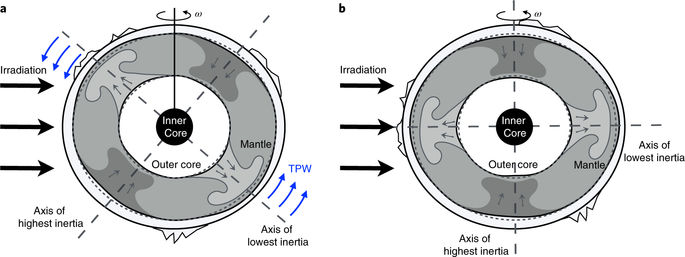Nature Geoscience ( IF 15.7 ) Pub Date : 2018-02-26 , DOI: 10.1038/s41561-018-0071-2 Jérémy Leconte 1

|
Many known rocky exoplanets are thought to have been spun down by tidal interactions to a state of synchronous rotation, in which a planet’s period of rotation is equal to that of its orbit around its host star. Investigations into atmospheric and surface processes occurring on such exoplanets thus commonly assume that day and night sides are fixed with respect to the surface over geological timescales. Here we use an analytical model to show that true polar wander—where a planetary body’s spin axis shifts relative to its surface because of changes in mass distribution—can continuously reorient a synchronous rocky exoplanet. As occurs on Earth, we find that even weak mantle convection in a rocky exoplanet can produce density heterogeneities within the mantle sufficient to reorient the planet. Moreover, we show that this reorientation is made very efficient by the slower rotation rate of a synchronous planet when compared with Earth, which limits the stabilizing effect of rotational and tidal deformations. Furthermore, a relatively weak lithosphere limits its ability to support remnant loads and stabilize against reorientation. Although uncertainties exist regarding the mantle and lithospheric evolution of these worlds, we suggest that the axes of smallest and largest moment of inertia of synchronous exoplanets with active mantle convection change continuously over time, but remain closely aligned with the star–planet and orbital axes, respectively.
中文翻译:

由于地幔对流,同步类地行星的连续重新定向
许多已知的岩石系外行星被认为已被潮汐相互作用旋转到同步旋转状态,在这种状态下,行星的自转周期与其围绕其主恒星的轨道周期相等。因此,对发生在此类系外行星上的大气和地表过程的研究通常假设,在地质时间尺度上,昼夜两面相对于地表是固定的。在这里,我们使用一个分析模型来展示真正的极地漂移——由于质量分布的变化,行星体的自旋轴相对于其表面发生移动——可以不断地重新定向一颗同步的岩石系外行星。正如地球上发生的那样,我们发现即使是岩石系外行星中的弱地幔对流也会在地幔内产生足以重新定向地球的密度不均匀性。而且,我们表明,与地球相比,同步行星的自转速度较慢,使得这种重新定向非常有效,这限制了自转和潮汐变形的稳定作用。此外,相对较弱的岩石圈限制了其支撑残余载荷和稳定重新定向的能力。尽管这些世界的地幔和岩石圈演化存在不确定性,但我们认为具有活跃地幔对流的同步系外行星的最小和最大转动惯量轴随时间不断变化,但仍与恒星-行星和轨道轴紧密对齐,分别。相对较弱的岩石圈限制了其支持残余载荷和稳定以防止重新定向的能力。尽管这些世界的地幔和岩石圈演化存在不确定性,但我们认为具有活跃地幔对流的同步系外行星的最小和最大转动惯量轴随时间不断变化,但仍与恒星-行星和轨道轴紧密对齐,分别。相对较弱的岩石圈限制了其支持残余载荷和稳定以防止重新定向的能力。尽管这些世界的地幔和岩石圈演化存在不确定性,但我们认为具有活跃地幔对流的同步系外行星的最小和最大转动惯量轴随时间不断变化,但仍与恒星-行星和轨道轴紧密对齐,分别。











































 京公网安备 11010802027423号
京公网安备 11010802027423号